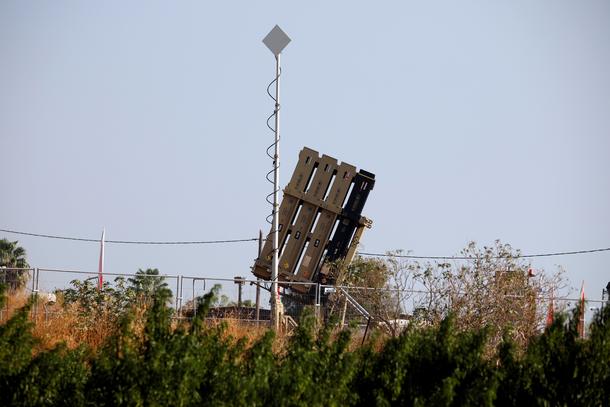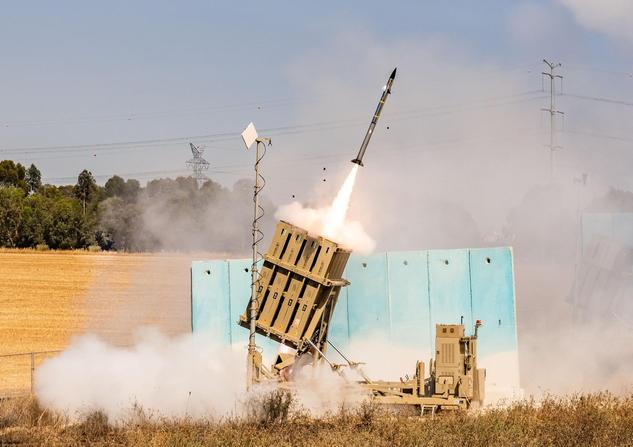In light of the current conflict between Russia on the one hand and Ukraine supported by the United States of America and the West on the other hand, the story of the “Iron Dome” anti-missile system that Kyiv asked Israel to supply, but Tel Aviv refused for fear of its impact on its relations with Moscow, surfaced.
The Iron Dome is a missile defense system in Israel, but it is a joint project with the US Department of Defense, and the agreement between the two parties does not allow the system to be sold to a third country without joint consent, according to the Israeli newspaper Yedioth Ahronoth.
The Israeli newspaper, Yedioth Ahronoth, revealed today, Tuesday, February 15, 2022, that Kyiv's request to obtain the military system came last year, and it was recently renewed.
Yesterday, Sunday, February 13, 2022, the Israeli Broadcasting Corporation quoted Israeli Foreign Minister Yair Lapid as saying that Ukraine had requested military assistance from Israel, and that it was looking into this request, without further details.
What is iron dome?
Iron Dome is designed to fire a lot of fire to deal with short-range missiles and heavy artillery shells, and one battery contains 8 launchers, each containing 20 interceptor missiles, and multiple missiles can be launched simultaneously.
The interceptor missile is launched if the threatening missiles will fall over populated areas and near residential areas and strategic locations, as the Israeli army claimed that the Iron Dome was able to intercept 80% of the missiles that pose a threat and fall within populated areas.
Iron Dome has a minimum range of 4.5 kilometers to intercept threatening missiles, which means it is difficult to intercept missiles at short range.
The Iron Dome operates in various weather conditions and conditions. The system includes a vehicle for movement that is easy to move from one place to another. It relies on a radar, an air tracking system, and a battery containing 8 missile launchers.
Each launcher includes 20 interceptor missiles, each of which costs at least 50 thousand dollars, meaning that one launcher needs interceptor missiles tens of thousands of dollars, and the high cost was one of the most important criticisms leveled against the system.
The cost of the missile price is high compared to the resistance missile, which costs several hundred dollars, but the military industries justified that because it remains less expensive than the new Patriot missile, which costs 3-5 million dollars.
David's sling
The system as a whole is intended for multiple goals, including repelling short-range missiles and artillery shells of 155 mm caliber, with a range of up to 70 km. The system includes a radar, tracking system and a battery of 20 interceptor missiles under the name “TAMIR”.
This system is known as David’s Sling, whose implementation contract was first signed with the American company Raytheon, where the Israeli company “Rafael” awarded the American company two contracts worth more than $100 million in order to design the system, which represents a joint program between The US Missile Defense Agency and the Missile Defense Organization, to counter short-range ballistic missiles, heavy-caliber missiles, and cruise missiles in the final stage of flight.
The first contract was awarded for the joint development of the Stunner interceptor, which consists of an advanced direct-hit interceptor designed to be part of David's Sling and allied integrated air and missile defense systems.
As for the second contract, it is related to the development, production and logistical support of the MFU missile launch unit, the part that gives the system a vertical launch capability of the interceptor missile covering the 360-degree expanded air and missile defense capability.
In addition, Stanner missiles are often used in multiple engagement scenarios that combine ground, sea and air sensors, and provide high flexibility in terms of deployment of soldiers and military operations.
The system does not differ, in principle, from the idea of the American missile shield, with a difference in the wider field and advanced technologies linked to satellite tracking networks to counter long-range and intercontinental missiles.
The system relies on an interceptor missile equipped with a warhead capable of intercepting and detonating any target in the air after the radar system detects and identifies the missile or artillery shell and tracks the trajectory of the projectile.
After that, the coordinates and information are transferred to the Battle Management, Control and Monitoring Unit to analyze the path of the target and determine the date and place of its supposed fall.

The intercept missile receives the coordinates of the target path from the battle management unit via the satellite communications uplink.

When the interceptor missile approaches its target, it uses its own radar to pick up the trajectory and orient itself to the required distance. When approaching the target, the warhead is detonated to destroy the target in the air without hitting it directly.
The warhead of the missile contains 11 kilograms of high explosives, with a range of 4 to 70 kilometers. The cost of one missile is 62 thousand dollars.
The second war on Lebanon
2006: During the second war on Lebanon (July 12-August 14), Israel realized that it needed to develop defense systems to counter short-range missiles and anti-armor rockets, and fortify the home front, which made it think about hiring military industries and the security establishment. Israel is developing this system.
During the war, Hezbollah fired about 4,000 Katyusha rockets, which showed the fragility of the northern home front even beyond Haifa. In parallel, the Israeli army launched a military operation against Gaza called “Sword of Gilad,” which prompted the resistance to launch 8,000 rockets towards Gaza envelope settlements.
- The resistance's shells from Gaza bypassing the "Gaza envelope" settlements, and their landing in Israeli towns 40 kilometers away, disturbed the Israeli home front, which is no longer safe under the new situation.
February 2007: Amir Peretz - Defense Minister in the government of former Prime Minister Ehud Olmert - issued his recommendations in order to practically begin developing a defense system for Israeli airspace from missiles, rockets and drones.
Tel Aviv named its military innovation "Iron Dome", a portable active air defense system to intercept short-range missiles, mortars and unmanned aerial vehicles.
- Manufacturing began with economic assistance from the United States, and an initial budget of $250 million was allocated, as the system was developed and manufactured by Rafael and Elta, which developed and manufactured the radar, while Empress developed the command and control system.
Trial operation
- End of 2010: The first Dome defense systems entered trial operation, and were practically tested in maneuvers simulating a military operation on the Gaza Strip front. The system designed to repel short-range missiles and artillery shells with a range of up to 70 kilometers was tested.
March 2008: Israel took advantage of the war on Gaza to develop the system, after the resistance's missiles reached for the first time the town of Ashkelon, which is more than 80 kilometers from Gaza.
- Israel returned to its development again in the same year, according to developments and the development of the resistance’s capabilities and missiles, during the military operation on Gaza, the Battle of Al-Furqan “Cast Lead” between December 2008 to January 18, 2009.
947th Battalion
- End of March 2011: The Iron Dome system entered operational service as part of the "947th Battalion" of the air defense system of the Israeli Air Force. The system is one of 4 operational systems that make up the multi-layered Israeli defense system.
November 2012: With the expansion of the range of resistance rockets fired from Gaza and their arrival in Tel Aviv, the Israeli military and air industries continued to develop the Iron Dome system, during Operation Shale Stone "Pillar of Cloud".
July 2014: Field tests also continued during Operation Protective Edge.
10 Iron Dome batteries have been introduced to operate and serve the Israeli Air Force, and the cost of producing one battery is estimated at $100 million, in addition to $300 million for the interceptor missiles that are supplied with one battery.
November 2017: The ability to intercept mortars was added, and the Naval Iron Dome system was announced, which was installed on the ships of the Israeli Navy, the cost of which to produce one advanced missile ranges from 15,000 to 65,000 dollars.
May 2021: Tel Aviv finished the preparations for Iron Dome missiles when Israel ignited large-scale confrontations with the Palestinians after it intensified its settlement efforts in Palestinian neighborhoods near the Old City of Jerusalem and its violent storming of the Al-Aqsa Mosque.
September 2021: Within 48 hours, a small group of progressive US House Democrats known as "The Squad" block a measure requiring Washington to bear the costs of renewing the Iron Dome project.
October 2021: Battles erupted again in the corridors of Congress, blocking the approval of additional military funding of one billion dollars for Israel for a short period.
However, the amount allocated to Iron Dome was soon reintroduced as a separate, stand-alone bill, as it was approved by an overwhelming majority and only 9 deputies opposed it, while two deputies - one of whom was Alexandria Ocasio-Cortez, a prominent member of the "faction" - were practically abstained. about voting.
February 2022: The resistance factions have proven that they are constantly studying the effectiveness of the Iron Dome system and trying to circumvent it mainly by launching intense and continuous barrages of dozens of missiles at a multiple and different range, which was revealed during the military aggression on Gaza.
- It is estimated that the Islamic Resistance Movements (Hamas) and Islamic Jihad possess about 15,000 missiles, more than what the Israeli intelligence estimated before the fighting, and tens and perhaps hundreds of missiles from a range of 160 km, which could reach beyond Tel Aviv, and that would When you reach the power station in Hadera, it is clear that Iron Dome will not be effective and is not a solution to the new reality.
- Even if 4 or 5 more iron domes are built in the coming years which will provide better spread and coverage from south to north, they will certainly not be able to withstand a barrage of tens of thousands of missiles no matter their extent.
The Israeli military and air industries are examining the possibility of modernizing the Iron Dome by developing a system for working with laser beams, to enable it to intercept missiles and missiles fired even from a short range and to confront intense bursts of missiles fired continuously without interruption and at the same time.
